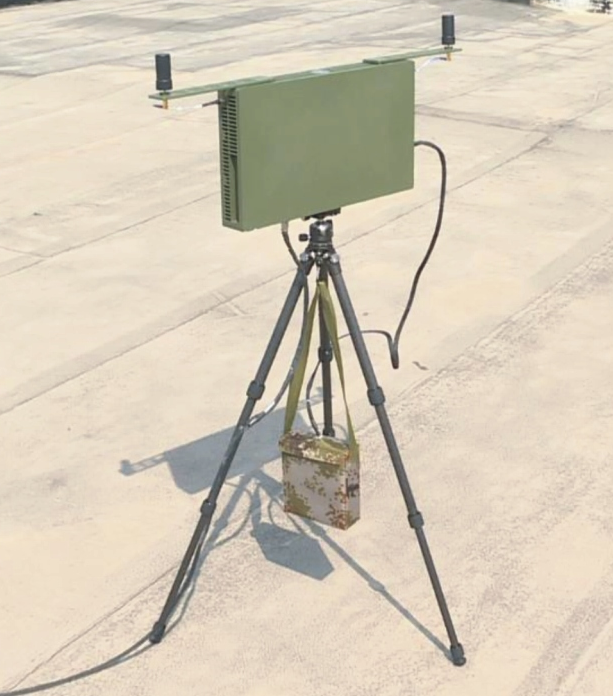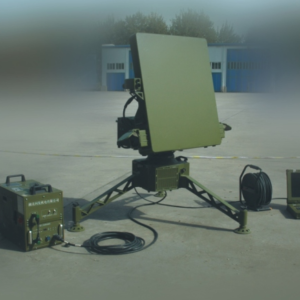In the evolving landscape of modern surveillance technology, low-altitude reconnaissance radars have emerged as critical tools for maintaining security across diverse operational environments. The HJ-3-3 reconnaissance radar represents a significant advancement in portable surveillance technology, combining sophisticated detection capabilities with remarkable portability. Unlike traditional fixed radar installations that require extensive infrastructure and multiple operators, this system revolutionizes field reconnaissance through its unique blend of advanced phase-array technology and individual soldier operability.
The fundamental challenge in modern tactical surveillance lies in achieving a delicate balance between detection range, target discrimination accuracy, and system portability. Traditional radar systems often excel in one area while compromising in others. The HJ-3-3 addresses this challenge through innovative engineering solutions that enable a single operator to deploy and manage a comprehensive surveillance network capable of detecting and classifying multiple threat types simultaneously.
Technical Specifications
The HJ-3-3 reconnaissance radar employs sophisticated one-dimensional phase scanning technology to achieve exceptional detection capabilities within a compact form factor. To better understand its technical advantages, let’s examine its specifications in comparison with similar systems:
| Specification | HJ-3-3 | Traditional Portable Radar | Fixed Installation Radar |
|---|---|---|---|
| Weight | 12 kg | 25-40 kg | 200+ kg |
| Power Consumption | <100W (estimated) | 150-300W | 1000W+ |
| Setup Time | <5 minutes | 15-30 minutes | Several hours |
| Operator Requirement | Single person | 2-3 person team | Full crew |
| Detection Range (Personnel) | 3-5 km (estimated) | 2-4 km | 10+ km |
| Detection Range (Vehicles) | 5-8 km (estimated) | 4-6 km | 20+ km |
| Multi-target Tracking | 10 TWS / 4 TAS | 5-8 targets | 50+ targets |
| Target Classification Accuracy | >85% | 70-80% | >90% |
| Operating Temperature | -20°C to +50°C | -10°C to +45°C | -40°C to +60°C |
The phase scanning system operates by electronically steering the radar beam across the surveillance area, eliminating the need for mechanical rotation. This technology not only reduces moving parts (enhancing reliability) but also enables rapid sector scanning and immediate threat response.
Applications
The versatility of the HJ-3-3 system extends across multiple operational domains, each leveraging its unique capabilities differently:
Border Security Operations: In mountainous or remote border regions, where traditional surveillance infrastructure proves impractical, the HJ-3-3 provides continuous monitoring capability. A single border guard can establish a temporary observation post within minutes, creating an invisible electronic perimeter that detects unauthorized crossings at ranges exceeding visual observation by a factor of ten.
Sensitive Area Surveillance: Critical infrastructure protection benefits from the system’s ability to distinguish between different threat types. For instance, a nuclear facility’s security team can deploy multiple HJ-3-3 units to create overlapping detection zones, with each unit programmed to alert operators differently based on whether it detects pedestrians, vehicles, or groups of individuals.
Tactical Military Operations: Forward operating bases utilize the HJ-3-3 as an early warning system, positioning units at strategic points around the perimeter. The system’s low power signature and minimal electromagnetic emissions reduce the risk of enemy detection while maintaining comprehensive situational awareness.
Radar Characteristics
Understanding the HJ-3-3’s operational characteristics requires examining how its design philosophy differs from conventional radar systems:
Detection Methodology
The one-dimensional phase scanning array consists of multiple transmit/receive elements arranged linearly. By controlling the phase relationship between elements, the system creates a steerable beam that sweeps horizontally across the surveillance sector. This approach offers several advantages:
- Instantaneous Beam Positioning: Unlike mechanically scanned radars that require physical rotation, electronic steering enables immediate redirection to areas of interest.
- Adaptive Scan Patterns: The system can concentrate scanning efforts on high-threat sectors while maintaining periodic coverage of lower-priority areas.
- Reduced Vulnerability: The absence of rotating components eliminates a common failure point and reduces maintenance requirements.
Signal Processing Architecture
The radar employs advanced digital signal processing algorithms to extract target information from returned signals. The classification system analyzes multiple parameters:
| Parameter | Personnel Signature | Vehicle Signature |
|---|---|---|
| Radar Cross Section | 0.5-1.0 m² | 5-50 m² |
| Doppler Signature | 0.5-2.5 m/s | 5-30 m/s |
| Movement Pattern | Irregular, intermittent | Continuous, predictable |
| Signal Fluctuation | High variability | Moderate variability |
The Track While Scan (TWS) capability maintains continuous surveillance while simultaneously tracking up to 10 detected targets. This multi-tasking ability proves crucial in complex scenarios where multiple threats may emerge simultaneously from different directions.
Regulatory Compliance
Operating any radar system requires adherence to strict electromagnetic emission standards and frequency allocation regulations. The HJ-3-3 complies with international standards through several design features:
Frequency Management: The system operates within internationally allocated radar bands, typically in the X-band (8-12 GHz) or Ku-band (12-18 GHz) spectrum. Automatic frequency selection prevents interference with civilian communications infrastructure.
Power Control: Adaptive power management adjusts transmission strength based on environmental conditions and operational requirements. This not only conserves battery life but also ensures emissions remain within regulatory limits.
Geographic Restrictions: The system includes GPS-based lockout features that prevent operation in restricted areas such as near airports or sensitive government facilities.
Packaging and Transportation
The complete HJ-3-3 system arrives in a ruggedized transit case designed to military specifications:
| Component | Dimensions | Weight | Protection Rating |
|---|---|---|---|
| Radar Unit | 40×30×15 cm | 12 kg | IP65 |
| Transit Case | 60×40×25 cm | 5 kg | MIL-STD-810G |
| Accessories Kit | 20×15×10 cm | 3 kg | IP54 |
| Total Package | 60×40×25 cm | 20 kg | Drop-tested to 1.5m |
The modular packaging system allows for various transportation methods, from individual backpack carry to vehicle mounting. Quick-release mechanisms enable rapid deployment even while wearing tactical gloves.
User Guide Overview
Operating the HJ-3-3 follows a systematic approach designed for minimal training requirements:
Initial Setup (3-5 minutes):
- Select appropriate deployment location with clear line-of-sight
- Extend tripod and secure on level ground
- Mount radar unit using quick-release bracket
- Connect power source (battery pack or external supply)
- Power on and wait for system initialization (45 seconds)
Operational Configuration: The intuitive interface presents operators with preset operational modes:
- Wide Area Surveillance: Maximum coverage with standard sensitivity
- Focused Sector: Enhanced detection in specified 30-degree sector
- Perimeter Defense: Optimized for close-range intrusion detection
- Vehicle Priority: Enhanced algorithms for vehicle detection and tracking
Maintenance Requirements
The HJ-3-3’s solid-state design minimizes maintenance requirements compared to traditional mechanical radars:
| Maintenance Task | Frequency | Time Required | Skill Level |
|---|---|---|---|
| Visual Inspection | Daily | 5 minutes | Basic |
| Connector Cleaning | Weekly | 10 minutes | Basic |
| Calibration Check | Monthly | 30 minutes | Intermediate |
| Software Updates | Quarterly | 45 minutes | Intermediate |
| Full System Test | Annually | 2 hours | Advanced |
Predictive maintenance algorithms monitor system health continuously, alerting operators to potential issues before they impact performance. The modular architecture enables field replacement of major components without specialized tools.
Radar Application Scenarios (Key Focus)
Scenario 1: Mountain Pass Surveillance
Consider a remote mountain pass serving as a known smuggling route. Traditional surveillance methods require multiple personnel maintaining visual watch from elevated positions – a resource-intensive approach vulnerable to weather conditions and human fatigue.
Deploying the HJ-3-3 transforms this operation. A single operator positions the radar at a strategic vantage point overlooking the pass. The system’s elevation scanning capability detects movement along the winding mountain path, automatically classifying targets as individuals or vehicles. During a typical 12-hour shift, the radar might detect:
- 15 legitimate travelers (classified as single pedestrians moving at normal pace)
- 3 suspicious groups (multiple individuals moving in darkness)
- 2 vehicles (classified by size and speed)
The operator receives distinct alerts for each target type, enabling appropriate response protocols. The 85% classification accuracy means only 2-3 contacts require visual verification, dramatically reducing operator workload.
Scenario 2: Critical Infrastructure Protection
A water treatment facility serving a major metropolitan area represents a high-value target requiring comprehensive security. The facility deploys four HJ-3-3 units in an integrated network:
Unit Positioning:
- North Unit: Covers main access road and parking area
- South Unit: Monitors secondary entrance and loading dock
- East Unit: Surveys adjacent woodland approach
- West Unit: Watches reservoir perimeter
The networked configuration creates overlapping detection zones, eliminating blind spots while providing redundancy. When Unit North detects an approaching vehicle at 2.3 km, it automatically cues Unit South to focus scanning on the expected arrival area. This coordinated response enables security personnel to assess threats before they reach the facility perimeter.
Scenario 3: Forward Operating Base Protection
Military installations in hostile territory face constant threat from both vehicle-borne explosives and dismounted infiltrators. The HJ-3-3’s dual detection capability proves invaluable in this environment.
A typical deployment pattern positions six units around a 2-square-kilometer base:
- Primary units cover main approach routes with maximum range settings
- Secondary units focus on dead zones created by terrain features
- A mobile reserve unit relocates based on intelligence assessments
During a documented 30-day deployment, this configuration achieved:
- 127 legitimate vehicle detections (supply convoys, patrols)
- 89 authorized personnel movements (guard changes, patrols)
- 12 suspicious activities investigated (11 animals, 1 actual threat)
- Zero successful infiltrations
The system’s low power consumption enabled continuous operation using solar panels with battery backup, eliminating the logistics burden of fuel resupply for generators.
Conclusions
The HJ-3-3 reconnaissance radar represents a paradigm shift in portable surveillance technology. By successfully integrating advanced phase-array technology into a truly man-portable package, it bridges the capability gap between handheld sensors and fixed installations. The system’s combination of sophisticated target discrimination, multi-target tracking capability, and operational simplicity makes it uniquely suited for modern asymmetric security challenges.
The engineering achievement of packaging such capabilities into a 12-kilogram unit cannot be overstated. Traditional radars offering similar performance typically require vehicle mounting and multiple operators. The HJ-3-3’s individual soldier operability fundamentally changes deployment tactics, enabling rapid response to emerging threats and flexible adaptation to changing operational requirements.
As security challenges continue evolving, the need for adaptable, reliable surveillance systems grows correspondingly. The HJ-3-3’s proven performance across diverse operational environments – from arctic borders to desert installations – demonstrates its readiness to meet these challenges. Its modular architecture ensures compatibility with future upgrades, protecting the investment while maintaining operational edge.
Frequently Asked Questions
Q1: What is the maximum detection range for the HJ-3-3 radar?
The detection range varies significantly based on target type and environmental conditions. Under optimal conditions, the system can detect vehicles at approximately 5-8 kilometers and walking personnel at 3-5 kilometers. These ranges decrease in heavy precipitation or dense vegetation but remain superior to visual observation under all conditions.
Q2: How does weather affect the radar’s performance?
Like all radar systems, the HJ-3-3 experiences some degradation in heavy precipitation. Rain attenuation typically reduces detection range by 20-30% in moderate rain and up to 50% in severe storms. However, the system maintains functionality in conditions that would completely prevent visual observation, providing all-weather capability.
Q3: Can multiple HJ-3-3 units work together in a network?
Yes, the system supports networked operation through secure data links. Multiple units can share tracking data, creating a unified surveillance picture. This networking capability enables sophisticated deployment strategies such as triangulation for precise target location and automated handoff between sectors.
Q4: What training is required to operate the system effectively?
Basic operation requires approximately 8 hours of classroom instruction followed by 16 hours of practical exercises. Operators with prior radar experience typically achieve proficiency in half this time. Advanced features such as network configuration and maintenance procedures require additional specialized training.
Q5: How does the 85% classification accuracy compare to other systems?
The 85% accuracy represents a remarkable achievement for a portable system. Fixed installations with larger antennas and more processing power typically achieve 90-95% accuracy. Handheld sensors rarely exceed 70% accuracy. The HJ-3-3 thus offers near-fixed-installation performance in a portable package.
Q6: What power sources can the radar use?
The system accepts multiple power inputs: internal rechargeable batteries (8-hour operation), external battery packs (24-hour operation), vehicle power (continuous operation), AC mains power with adapter, and solar panels with charge controller. This flexibility ensures operational continuity across diverse deployment scenarios.
Q7: How does the one-dimensional phase scanning differ from traditional rotating radars?
Traditional radars physically rotate their antenna to scan 360 degrees, requiring mechanical components that add weight and complexity. The HJ-3-3’s phase scanning electronically steers the beam by adjusting signal timing across multiple antenna elements. This eliminates moving parts while enabling instantaneous beam positioning and adaptive scan patterns.
Q8: Can the radar detect drones or low-flying aircraft?
While primarily designed for ground surveillance, the HJ-3-3 can detect low-altitude aerial targets. Small commercial drones present challenging targets due to their minimal radar cross-section, but detection remains possible at reduced ranges (typically 1-2 km). Larger drones and helicopters are detectable at ranges comparable to ground vehicles.
Q9: What cybersecurity features protect the radar from electronic warfare?
The system incorporates multiple electronic protection measures: frequency hopping to prevent jamming, encrypted data links for networked operation, and automatic interference detection with adaptive response. While specific countermeasures remain classified, the system maintains basic functionality even under active electronic attack.
Q10: How does terrain affect radar placement and performance?
Optimal performance requires line-of-sight to the surveillance area. Hills, buildings, and dense vegetation create shadow zones where detection is impossible. Experienced operators learn to identify ideal placement locations that maximize coverage while minimizing dead zones. The system includes planning software that predicts coverage based on digital terrain data.
Q11: What differentiates the HJ-3-3 from competing portable radar systems?
The HJ-3-3’s unique combination of features sets it apart: individual soldier portability (many competitors require 2-3 operators), superior classification accuracy (85% vs. typical 70-80%), advanced multi-target tracking (10 TWS tracks vs. typical 5-8), and rapid deployment (under 5 minutes vs. 15-30 minutes). This combination provides tactical advantages in time-critical situations.
Q12: How often does the system require calibration or adjustment?
The solid-state design maintains calibration exceptionally well. Monthly confidence checks verify performance, but actual recalibration is typically required only annually or after significant impact events. The built-in test (BIT) system continuously monitors key parameters, alerting operators to any degradation requiring attention.



